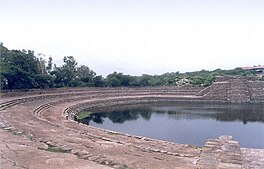| Surajkund | |
|---|---|
 View of Surajkund | |
| Location | Surajkund, Faridabad |
| Coordinates | 28°29′02″N 77°16′58″E / 28.48379°N 77.28270°E |
| Type | Reservoir |
| Basin countries | India |
| Settlements | Faridabad |
| References | [1] |
Surajkund is an ancient reservoir of the 10th century located on Southern Delhi Ridge of Aravalli range in Faridabad city of Haryana state about 8 km (5 mi) from South Delhi.[2] Surajkund (literally 'Lake of the Sun') is an artificial Kund ('Kund' means "lake" or reservoir) built in the backdrop of the Aravalli hills with an amphitheatre shaped embankment constructed in semicircular form. It is said to have been built by the king Surajpal of the Tomara Rajputs in the 10th century. Tomar, a younger son of Anangpal Tomar – the Rajput ruler of Delhi, was a sun worshipper and he had therefore built a Sun temple on its western bank.[2][3][4][5] Surajkund is known for its annual fair "Surajkund International Craft Mela", 2015 edition of this fair was visited by 1.2 million visitors including 160,000 foreigners with more than 20 countries participating in it.[6]
There are 43 paleolithic sites (100,000 BC), with rock art and microlithic stone tools, scattered surround the Surajkund from Mangar Bani in the west to Tuglaqabad in the northeast.[7][8]
It is an important biodiversity area within the Northern Aravalli leopard wildlife corridor stretching from Sariska Tiger Reserve to Delhi. Historical place around sanctuary are Badkhal Lake (6 km northeast), Anangpur Dam (16 km north), Damdama Lake, Tughlaqabad Fort and Adilabad ruins (both in Delhi), Chhatarpur Temple (in Delhi).[9] It is contiguous to the seasonal waterfalls in Pali-Dhuaj-Kot villages of Faridabad,[10] the sacred Mangar Bani and the Asola Bhatti Wildlife Sanctuary. There are several dozen lakes formed in the abandoned open pit mines in and around the area. Surajkund falls inside the leopard habitat.[11]
Another 'kund' by the same name as 'Suraj Kund' existed in Sunam in Punjab, which was sacked by Mahmood Ghaznvi or Taimur Lane, consequently now lies in ruins.[12]
- ^ "Suraj Kund Lake".
- ^ a b Sharma, Y.D (2001). Delhi and its Neighbourhood. New Delhi: Archaeological Survey of India. p. 100 in 161. Archived from the original on 31 August 2005. Retrieved 5 September 2009.
Page 100: Suraj Kund lies about 3 km south-east of Tughlaqabad in district Gurgaon---The reservoir is believed to have been constructed in the tenth century by King Surjapal of Tomar dynasty. Page 101: About 2 km south-west of Surajkund, close to the village of Anagpur (also called Arangpur) is a dam ascribed to Anagpal of the Tomar Dynasty, who is also credited with building the Lal Kot
{{cite book}}:|work=ignored (help) - ^ "Ticketed Monuments – Haryana: Suraj Kund". National Informatics Centre, Government of India. Retrieved 5 September 2009.
- ^ Peck, Lucy (2005). Delhi - A thousand years of Building. New Delhi: Roli Books Pvt Ltd. p. 29. ISBN 81-7436-354-8. Retrieved 5 September 2009.
{{cite book}}:|work=ignored (help) - ^ "The Fair". Retrieved 5 September 2009.
- ^ "29th Surajkund International Crafts Mela Ends". Ndtv.com. Retrieved 31 October 2015.
- ^ Cite error: The named reference
Singhwas invoked but never defined (see the help page). - ^ Cite error: The named reference
mangr2was invoked but never defined (see the help page). - ^ ASOLA BHATTI WILD LIFE SANCTUARY Archived 16 August 2011 at the Wayback Machine, Department of Forest, Delhi Government
- ^ पाली गांव की पहाड़ियों पर डैम बनाकर रोका जाएगा झरनों का पानी
- ^ Cite error: The named reference
suraj1was invoked but never defined (see the help page). - ^ "Places to Visit". Sunam & Suraj Kund. National Informatics Centre. Retrieved 7 September 2009.

